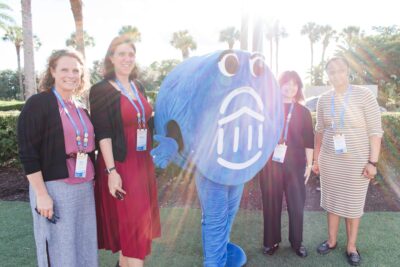The Pandemic Ripple Effect

When will the pandemic be over?
Who hasn’t asked this question at some point over the last two years? Our public health crisis will eventually reach an end, but even then, the pandemic won’t really be “over.” Like many other parts of society, higher education has been fundamentally disrupted, and we will be living with the ripple effects for years to come.
I’ve been especially concerned about the impact of the pandemic on student success and degree completion over the next decade. The National Student Clearinghouse reports an 8% industry-wide enrollment decline from Fall 2019 to Fall 2021. Persistence fell 2% over the same period, erasing gains made in recent years. These declines are distributed unevenly along racial and income lines, meaning that we have lost some of the progress we had made on improving college access and closing equity gaps over the last decade.
I interviewed dozens of college presidents, provosts, and other senior leaders across Fall 2021 about the intensifying student success challenges brought on by the pandemic. I found that while most schools were still (understandably) trying to deal with the immediate crisis at hand, a small handful had begun asking questions about the lasting impact, and how they might prepare.
To help you plan, we’ve identified four pandemic “ripple effects” that I believe will dominate the student success conversation for the next several years. We based our assessments on data gathered from a wide range of sources documenting student trends in postsecondary and K-12 school education. For each ripple effect, I offer suggested action steps drawn from the work of EAB best practice research and technology experts.
The Four Pandemic Ripple Effects-And How to Prepare for Them
1. Social Disengagement
Student engagement drives persistence. When campuses shut down in Spring 2020, students lost the parts of campus life that could not be moved online, including most social and community activities. Data from Fall 2021 suggests that social interactions are slowly returning, but we still have a long way to go.
In response, colleges need to redouble their efforts to build in-person engagement. Ironically, virtual communities hosted by colleges can play a key role in helping digital native students make connections that translate to in-person interactions and drive high-impact practices.
EXPLORE THE HALLMARKS OF A MODERN STUDENT EXPERIENCE
2. Student Mental Health
Mental health diagnoses have been on the rise for a decade, as has the demand on campus counseling centers. The pandemic supercharged this trend, with Active Minds finding that three-quarters of students reported that their mental health worsened to some degree. The effects of this trauma could linger for years.
In response, colleges must meet rising demand by extending their mental health services outside of overwhelmed counseling centers. Mental health touchpoints embedded into the curriculum and into residence life are proven to build awareness and reduce stigma, while self-service portals can help students connect with resources and support when they are ready.
READ THE STUDY: MEETING THE ESCALATING DEMAND FOR MENTAL HEALTH SUPPORT
3. Transfer Availability
Two-year colleges form the foundation of our transfer system, and nearly half of all bachelor’s degree recipients earn credits at two-year colleges during their education. Two-year enrollments are down 14% from Fall 2019 and Fall 2021, a decline that could be felt by the entire sector for years to come.
To prepare, ask your faculty to work with their counterparts at partner institutions to align curricula and allow more credits to articulate. Offer prospective transfer students a portal that allows then to easily assess how many of their credits you will accept. Finally, work with transfer partners to develop formal pathways that provide transfer students a seamless experience as they move between institutions.
BROWSE THE TRANSFER PORTAL RESOURCE HUB
4. Unfinished K-12 Learning
The challenges faced by K-12 students during the pandemic will soon have an impact on incoming college classes. Chronic absenteeism in high school doubled, threatening the size and academic preparation of future incoming classes. Students as far back as elementary school finished the 2020-2021 school year with 4-5 months of “unfinished learning,” meaning that lower levels of academic preparation could last until the early 2030s if we cannot help these students catch up.
To prepare, expand staffing and modernize the strategy, organization, and technology in your advising and student support offices. Schools that enroll large numbers of developmental students should immediately move to cocurricular developmental models if they have not done so already.
Don’t Panic
While the challenges ahead are daunting, there is reason for hope. The pandemic caused many problems, but it also forced change and innovation that is long overdue. Our faculty and staff have become experts at delivering virtual learning and support, allowing us to reach students we never would have reached before. In addition, our ongoing racial reckoning has brought widespread attention and investment to campus equity initiatives that previously struggled to gain momentum. Finally, federal pandemic relief to higher education has totaled $77 billion to date, representing a once-in-a-lifetime funding opportunity that many schools are using to invest in building sustainable futures.
With this momentum at their backs, college leaders can and should view their current circumstances as an opportunity to address and eliminate barriers to student success that existed long prior to the pandemic.

More Blogs

EAB Wrapped 2025: A year of reckoning—and reinvention—in higher ed

Four signs it’s time to break up with your student CRM
